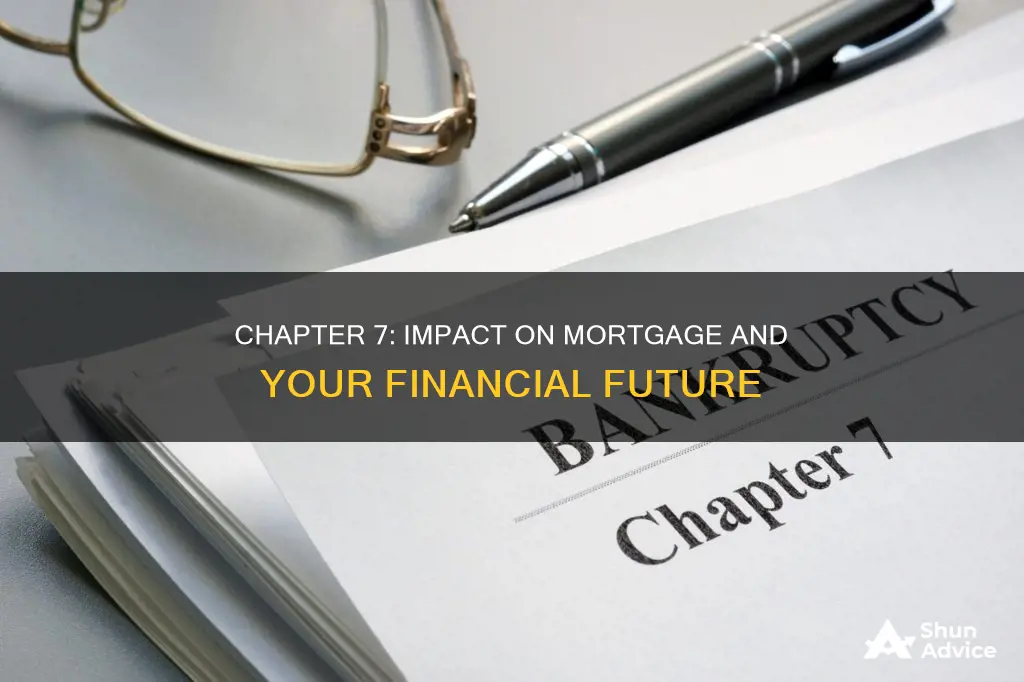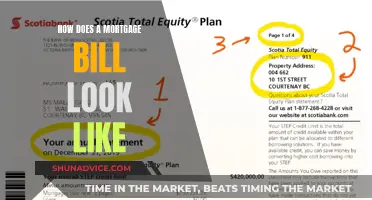
Chapter 7 bankruptcy, also known as straight or liquidation bankruptcy, is a common way to wipe out most or all of your outstanding debt. However, it's important to note that Chapter 7 bankruptcy doesn't eliminate your mortgage debt or the mortgage lien. While filing for Chapter 7 can provide a fresh start for those struggling financially, it doesn't automatically mean you'll lose your home. If you want to keep your home, you'll need to be current on your mortgage payments and protect your home equity with a bankruptcy exemption. After your Chapter 7 case ends, you must continue making timely mortgage payments to avoid foreclosure. Additionally, there is typically a waiting period of one to four years after a Chapter 7 discharge before you can qualify for a new mortgage, giving you time to rebuild your credit score.
How does filing for Chapter 7 bankruptcy affect my mortgage?
| Characteristics | Values |
|---|---|
| Filing for Chapter 7 bankruptcy | Wipes out your mortgage obligation but does not eliminate the mortgage lien |
| Before filing for Chapter 7 bankruptcy | Ensure you are current on your mortgage payments and can protect all of the equity with a bankruptcy exemption |
| After filing for Chapter 7 bankruptcy | You will have to continue making timely mortgage payments. If you don't, your lender will foreclose on your home and sell it at auction |
| Getting a mortgage after filing for Chapter 7 bankruptcy | You may become eligible for a home loan 1-4 years after receiving your bankruptcy discharge, depending on the type of mortgage |
What You'll Learn

Chapter 7 bankruptcy and mortgage debt
Chapter 7 bankruptcy, also known as "straight" or "liquidation" bankruptcy, involves a liquidation of your assets, which are used to pay off unsecured debt. While filing for Chapter 7 bankruptcy can wipe out your mortgage obligation, it does not eliminate the mortgage lien. This means that if you are unable to pay your mortgage, your lender can still foreclose on your home. Therefore, it is important to continue making timely mortgage payments even after your Chapter 7 case ends.
If you are current on your loan payments, you can reaffirm your loan in a Chapter 7 bankruptcy. However, if you are behind on your payments, Chapter 7 may not be the best option as it does not provide a repayment plan. In this case, you may want to consider Chapter 13 bankruptcy, which allows for catch-up payments and can help you keep your property.
The impact of Chapter 7 bankruptcy on your ability to obtain a future mortgage also depends on the type of loan you are seeking. Typically, there is a waiting period of one to four years after a Chapter 7 bankruptcy discharge before you become eligible for a new mortgage. During this time, you can work on improving your credit score and demonstrating your ability to manage mortgage payments.
It is important to note that the waiting period for a new mortgage may vary depending on the number of bankruptcy cases you have filed and whether you have a foreclosure on your record. Additionally, the specific requirements and waiting periods may differ based on the home loan program you are applying for.
Commission Earnings and Mortgage Eligibility: What You Need to Know
You may want to see also

Foreclosure and Chapter 7
Chapter 7 bankruptcy is a way for debtors to get rid of their debts. It is also known as "straight" or "liquidation" bankruptcy. It wipes out much (or all) of your outstanding debt. However, it does not eliminate the mortgage lien. If you are behind on your mortgage payments with no feasible way to get current before foreclosure, filing for Chapter 13 bankruptcy might be a better option.
Chapter 7 bankruptcy provides temporary relief through an automatic stay, which halts foreclosure proceedings for a few months. It can also free up money so you can more easily make your mortgage payments by eliminating other debts. However, keeping your home under Chapter 7 is only possible if you are current on mortgage payments and can protect your equity using exemptions; it doesn't offer a mechanism to catch up on missed payments. If you want to keep your home, you need to keep making your payments before, during, and after bankruptcy. To prevent foreclosure, you must make up any already-missed payments and keep your payments current.
If you want to keep your home, consider filing for Chapter 13. People who can afford a hefty monthly Chapter 13 payment can catch up on late payments and keep their homes. Chapter 13 is the chapter that allows filers to catch up on payments and keep property, making it a better choice for those who want to retain their homes. Chapter 13 bankruptcy payment plans can include an agreement about your mortgage. Debtors spread the missed payments out over a repayment plan of three to five years.
Energy Efficient Mortgages: Save Money, Conserve Energy
You may want to see also

Chapter 7 bankruptcy and loan reaffirmation
Chapter 7 bankruptcy, also known as "straight", "liquidation", or "total" bankruptcy, wipes out most or all of your outstanding debts. However, it does not eliminate the mortgage lien on your property, and you will still need to make timely mortgage payments to avoid foreclosure. If you want to keep your home, you must be current on your mortgage payments and protect all of the equity with a bankruptcy exemption before filing.
In a Chapter 7 bankruptcy, you must disclose whether you intend to keep or surrender certain properties, such as your house. Even if you want to keep your property and continue paying for it, your lender might decide to take it back if you don't "reaffirm" the debt by entering into a new contract to replace the one unwound in Chapter 7. When you reaffirm a debt, you sign a new agreement that makes you personally liable for that loan again, giving up the benefits of your bankruptcy discharge.
It is important to carefully consider the pros and cons of reaffirming your debts. While reaffirming a debt may help you keep your property, it also means giving up the protection of bankruptcy for that debt. This means that if you are unable to make your payments in the future, your lender can take legal action against you, and the debt will appear on your credit report. Additionally, if your property is significantly underwater (the balance of the loan exceeds the value of the property), reaffirming may not be in your best interest. In some cases, if you don't reaffirm the debt and the lender repossesses the property, they cannot pursue you for the deficiency.
Before making any decisions, it is essential to seek legal advice and fully understand the potential consequences of reaffirming a debt.
Mortgage Servicers: Making Money by Managing Your Home Loan
You may want to see also

Getting a mortgage after Chapter 7 bankruptcy
Chapter 7 bankruptcy, also known as "straight" or "liquidation" bankruptcy, is a common option for those with limited income who need to wipe out their outstanding debt. While filing for bankruptcy can offer relief from overwhelming debt, it can also affect your ability to get a mortgage in the future.
When you file for Chapter 7 bankruptcy, you will likely have to liquidate many of your assets and use the proceeds to pay off your creditors. This can include your existing property, as bankruptcy will wipe out your mortgage obligation. However, it's important to note that it doesn't eliminate the mortgage lien, and you may have to give up your home if you're unable to continue making timely mortgage payments.
After filing for Chapter 7 bankruptcy, you will typically need to wait for a period of time before you can apply for a new mortgage. This waiting period can range from one to four years, depending on the type of mortgage you're seeking. During this time, it's crucial to focus on rebuilding your credit and finances. This includes improving your credit score, saving for a down payment, establishing reliable income, and demonstrating a track record of paying bills on time.
While it may be challenging, it is possible to get a mortgage after Chapter 7 bankruptcy. Conventional (non-government) mortgages typically have a four-year waiting period after Chapter 7 discharge. Government-backed loans, such as FHA, VA, or USDA loans, may have shorter waiting periods, but they still require borrowers to show responsible credit management since their bankruptcy. Additionally, there are limited-availability programs that may allow Chapter 7 debtors to qualify for FHA financing in as little as one year if they can prove that their financial issues were due to extreme circumstances beyond their control.
Reporting Mortgage Insurance Premiums: A Comprehensive Guide
You may want to see also

Chapter 7 bankruptcy and asset liquidation
Chapter 7 bankruptcy, also known as "straight", "total", or "liquidation" bankruptcy, is a legal process that allows individuals or businesses to discharge or wipe out most of their debts, providing a fresh start. It is available to individuals who cannot make regular, monthly payments toward their debts.
When filing for Chapter 7 bankruptcy, a bankruptcy trustee is appointed to review the debtor's non-exempt assets and finances. Exempt property, or property necessary to maintain a basic standard of living, is retained by the debtor. Nonexempt property is seized and liquidated to pay creditors. Property exemptions vary in each state, but debtors are often allowed to keep their primary home, personal possessions, and car.
The proceeds from the liquidation of assets are used to pay off creditors in the following order: first, unsecured priority debts, such as tax debts, child support, and personal injury claims; second, secured debts; and last, nonpriority unsecured debts. It is important to note that filing for Chapter 7 bankruptcy may require the forfeiture of certain assets to satisfy creditors.
While Chapter 7 bankruptcy can provide financial relief, it is important to understand that it does not eliminate the mortgage lien. This means that if you own a home, you will still need to make timely mortgage payments after your Chapter 7 case ends. If you are unable to make these payments, your lender can foreclose on your home and sell it to pay off your debt. Therefore, if you want to keep your home, it is crucial to ensure that you are current on your mortgage payments before filing for Chapter 7 bankruptcy and that you can protect all of the equity with a bankruptcy exemption.
Car Finance and Your Mortgage: What You Need to Know
You may want to see also
Frequently asked questions
No, filing for Chapter 7 bankruptcy does not automatically mean that you will lose your home. However, if you are unable or unwilling to continue paying your mortgage, the lender may foreclose on your home.
Chapter 7 bankruptcy forgives your debts by liquidating your assets. This means that a court-appointed trustee will sell your assets to pay off your debts. However, it is important to note that Chapter 7 bankruptcy does not discharge mortgage debt specifically.
The waiting period to qualify for a new mortgage after filing for Chapter 7 bankruptcy typically ranges from one to four years, depending on the type of mortgage and your financial situation. During this time, you can work on rebuilding your credit score and demonstrating your ability to manage mortgage payments.







